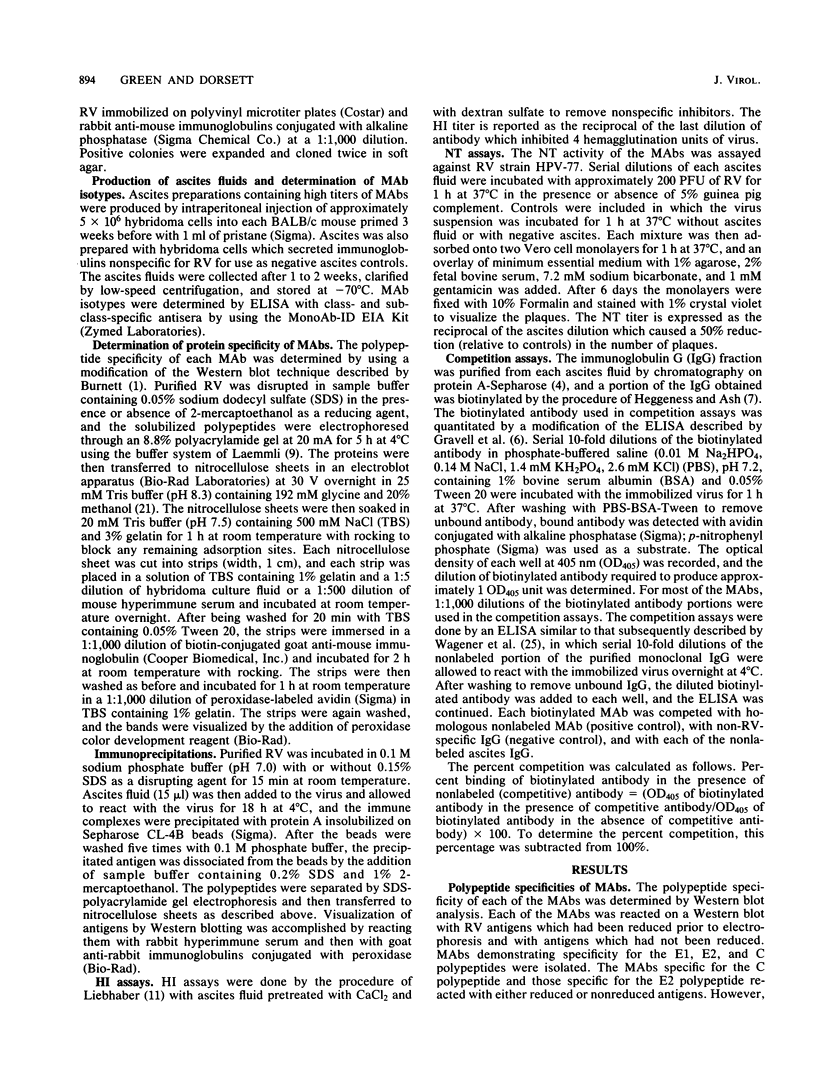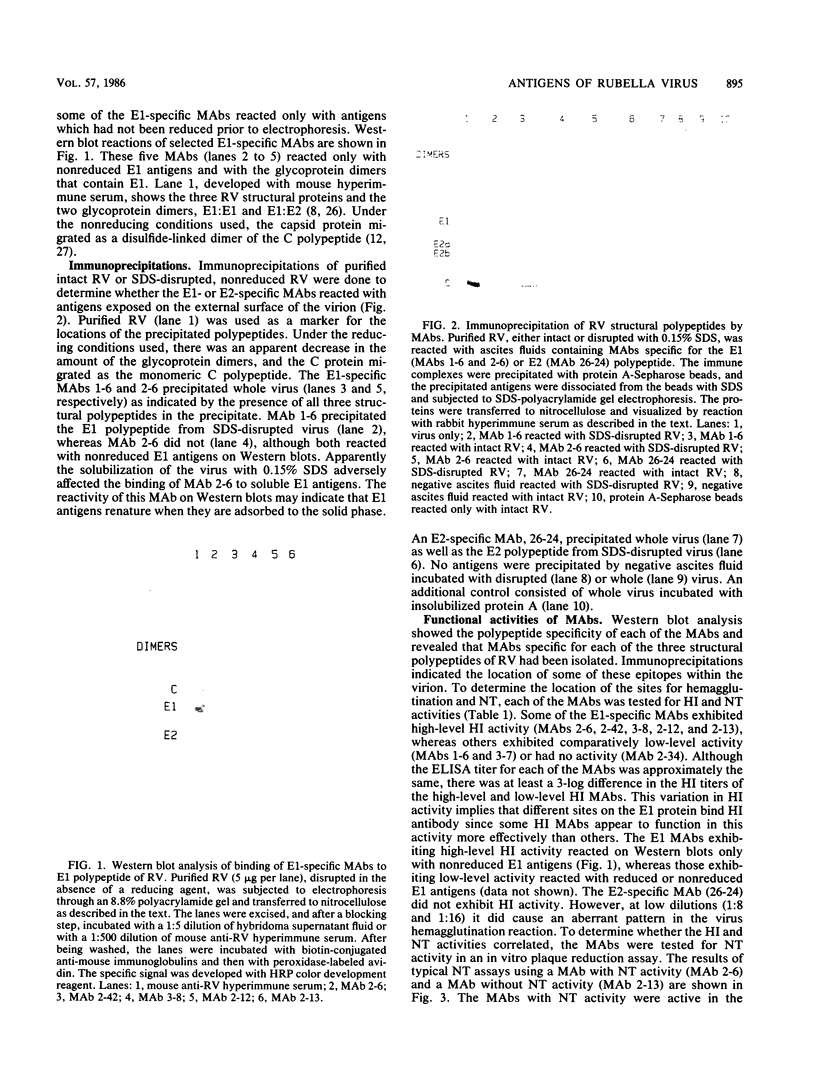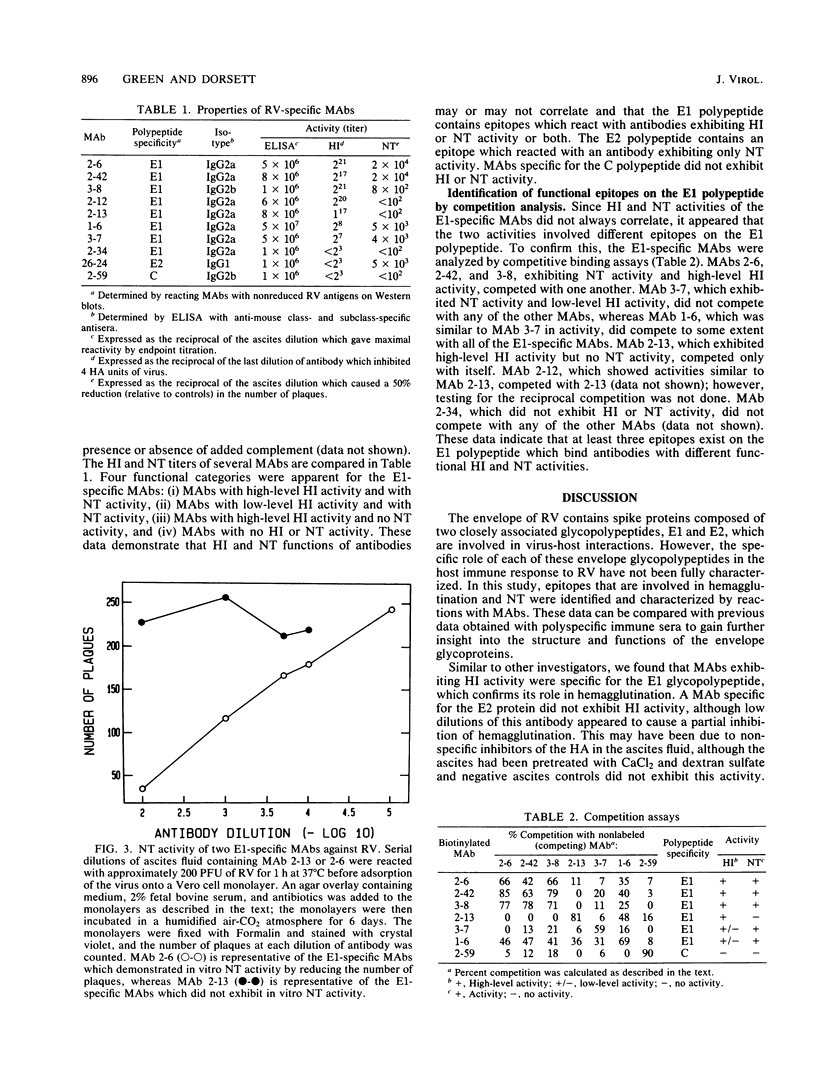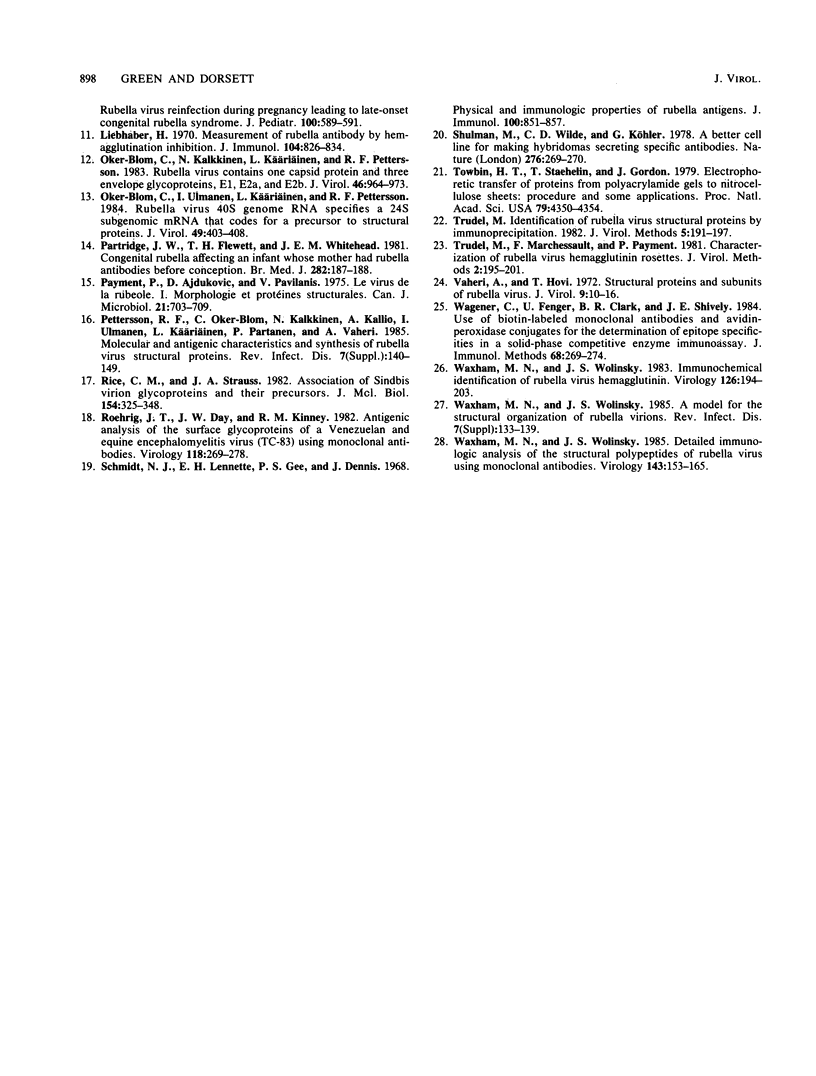Abstract
Monoclonal antibodies (MAbs) against the rubella virion were used to locate epitopes involved in hemagglutination and neutralization. The MAbs exhibiting high-level hemagglutination-inhibiting activity were shown by Western blot analysis to be specific for the E1 polypeptide; this is consistent with the presence of the hemagglutinin on the E1 polypeptide. Some of the E1-specific MAbs also neutralized viral infectivity. However, hemagglutination-inhibiting activity and neutralizing activity did not always correlate. Three distinct functional epitopes were identified on the E1 polypeptide by competition analyses: one which reacted with MAbs with high-level hemagglutination-inhibiting activity and with neutralizing activity, one which reacted with MAbs with low-level hemagglutination-inhibiting activity and with neutralizing activity, and one which reacted with MAbs with only hemagglutination-inhibiting activity. A MAb specific for the E2 polypeptide exhibited neutralizing activity. This E2-specific MAb and two E1-specific MAbs with neutralizing activity were capable of precipitating intact virus which indicates that at least three epitopes involved in neutralization are accessible on the surface of the virion.
Full text
PDF





Images in this article
Selected References
These references are in PubMed. This may not be the complete list of references from this article.
- Burman L. A., Norrby R., Trollfors B. Invasive pneumococcal infections: incidence, predisposing factors, and prognosis. Rev Infect Dis. 1985 Mar-Apr;7(2):133–142. doi: 10.1093/clinids/7.2.133. [DOI] [PubMed] [Google Scholar]
- Burnette W. N. "Western blotting": electrophoretic transfer of proteins from sodium dodecyl sulfate--polyacrylamide gels to unmodified nitrocellulose and radiographic detection with antibody and radioiodinated protein A. Anal Biochem. 1981 Apr;112(2):195–203. doi: 10.1016/0003-2697(81)90281-5. [DOI] [PubMed] [Google Scholar]
- Cappel R., De Cuyper F. Efficacy and immune response to rubella subunits vaccines. Arch Virol. 1976;50(3):207–213. doi: 10.1007/BF01320574. [DOI] [PubMed] [Google Scholar]
- Ey P. L., Prowse S. J., Jenkin C. R. Isolation of pure IgG1, IgG2a and IgG2b immunoglobulins from mouse serum using protein A-sepharose. Immunochemistry. 1978 Jul;15(7):429–436. doi: 10.1016/0161-5890(78)90070-6. [DOI] [PubMed] [Google Scholar]
- Gefter M. L., Margulies D. H., Scharff M. D. A simple method for polyethylene glycol-promoted hybridization of mouse myeloma cells. Somatic Cell Genet. 1977 Mar;3(2):231–236. doi: 10.1007/BF01551818. [DOI] [PubMed] [Google Scholar]
- Heggeness M. H., Ash J. F. Use of the avidin-biotin complex for the localization of actin and myosin with fluorescence microscopy. J Cell Biol. 1977 Jun;73(3):783–788. doi: 10.1083/jcb.73.3.783. [DOI] [PMC free article] [PubMed] [Google Scholar]
- Ho-Terry L., Cohen A. Degradation of rubella virus envelope components. Arch Virol. 1980;65(1):1–13. doi: 10.1007/BF01340535. [DOI] [PubMed] [Google Scholar]
- Laemmli U. K. Cleavage of structural proteins during the assembly of the head of bacteriophage T4. Nature. 1970 Aug 15;227(5259):680–685. doi: 10.1038/227680a0. [DOI] [PubMed] [Google Scholar]
- Liebhaber H. Measurement of rubella antibody by hemagglutination inhibition. II. Characteristics of an improved HAI test employing a new method for the removal of non-immunoglobulin HA inhibitors from serum. J Immunol. 1970 Apr;104(4):826–834. [PubMed] [Google Scholar]
- Oker-Blom C., Kalkkinen N., Käriäinen L., Pettersson R. F. Rubella virus contains one capsid protein and three envelope glycoproteins, E1, E2a, and E2b. J Virol. 1983 Jun;46(3):964–973. doi: 10.1128/jvi.46.3.964-973.1983. [DOI] [PMC free article] [PubMed] [Google Scholar]
- Oker-Blom C., Ulmanen I., Käriäinen L., Pettersson R. F. Rubella virus 40S genome RNA specifies a 24S subgenomic mRNA that codes for a precursor to structural proteins. J Virol. 1984 Feb;49(2):403–408. doi: 10.1128/jvi.49.2.403-408.1984. [DOI] [PMC free article] [PubMed] [Google Scholar]
- Partridge J. W., Flewett T. H., Whitehead J. E. Congenital rubella affecting an infant whose mother had rubella antibodies before conception. Br Med J (Clin Res Ed) 1981 Jan 17;282(6259):187–188. doi: 10.1136/bmj.282.6259.187. [DOI] [PMC free article] [PubMed] [Google Scholar]
- Payment P., Ajdukovic D., Pavilanis V. Le virus de la rubéole. I. Morphologie et protéines structurales. Can J Microbiol. 1975 May;21(5):703–709. [PubMed] [Google Scholar]
- Rice C. M., Strauss J. H. Association of sindbis virion glycoproteins and their precursors. J Mol Biol. 1982 Jan 15;154(2):325–348. doi: 10.1016/0022-2836(82)90067-5. [DOI] [PubMed] [Google Scholar]
- Roehrig J. T., Day J. W., Kinney R. M. Antigenic analysis of the surface glycoproteins of a Venezuelan equine encephalomyelitis virus (TC-83) using monoclonal antibodies. Virology. 1982 Apr 30;118(2):269–278. doi: 10.1016/0042-6822(82)90346-4. [DOI] [PubMed] [Google Scholar]
- Schmidt N. J., Lennette E. H., Gee P. S., Dennis J. Physical and immunologic properties of rubella antigens. J Immunol. 1968 Apr;100(4):851–857. [PubMed] [Google Scholar]
- Shulman M., Wilde C. D., Köhler G. A better cell line for making hybridomas secreting specific antibodies. Nature. 1978 Nov 16;276(5685):269–270. doi: 10.1038/276269a0. [DOI] [PubMed] [Google Scholar]
- Towbin H., Staehelin T., Gordon J. Electrophoretic transfer of proteins from polyacrylamide gels to nitrocellulose sheets: procedure and some applications. Proc Natl Acad Sci U S A. 1979 Sep;76(9):4350–4354. doi: 10.1073/pnas.76.9.4350. [DOI] [PMC free article] [PubMed] [Google Scholar]
- Trudel M., Marchessault F., Payment P. Characterisation of rubella virus hemagglutinin rosettes. J Virol Methods. 1981 Mar;2(4):195–201. doi: 10.1016/0166-0934(81)90009-4. [DOI] [PMC free article] [PubMed] [Google Scholar]
- Trudel M., Nadon F., Comtois R., Payment P., Bonneau A. M., Lecomte J. Identification of rubella virus structural proteins by immunoprecipitation. J Virol Methods. 1982 Nov;5(3-4):191–197. doi: 10.1016/0166-0934(82)90009-x. [DOI] [PubMed] [Google Scholar]
- Vaheri A., Hovi T. Structural proteins and subunits of rubella virus. J Virol. 1972 Jan;9(1):10–16. doi: 10.1128/jvi.9.1.10-16.1972. [DOI] [PMC free article] [PubMed] [Google Scholar]
- Wagener C., Fenger U., Clark B. R., Shively J. E. Use of biotin-labeled monoclonal antibodies and avidin-peroxidase conjugates for the determination of epitope specificities in a solid-phase competitive enzyme immunoassay. J Immunol Methods. 1984 Mar 30;68(1-2):269–274. doi: 10.1016/0022-1759(84)90157-1. [DOI] [PubMed] [Google Scholar]
- Waxham M. N., Wolinsky J. S. Detailed immunologic analysis of the structural polypeptides of rubella virus using monoclonal antibodies. Virology. 1985 May;143(1):153–165. doi: 10.1016/0042-6822(85)90104-7. [DOI] [PubMed] [Google Scholar]
- Waxham M. N., Wolinsky J. S. Immunochemical identification of rubella virus hemagglutinin. Virology. 1983 Apr 15;126(1):194–203. doi: 10.1016/0042-6822(83)90471-3. [DOI] [PubMed] [Google Scholar]




